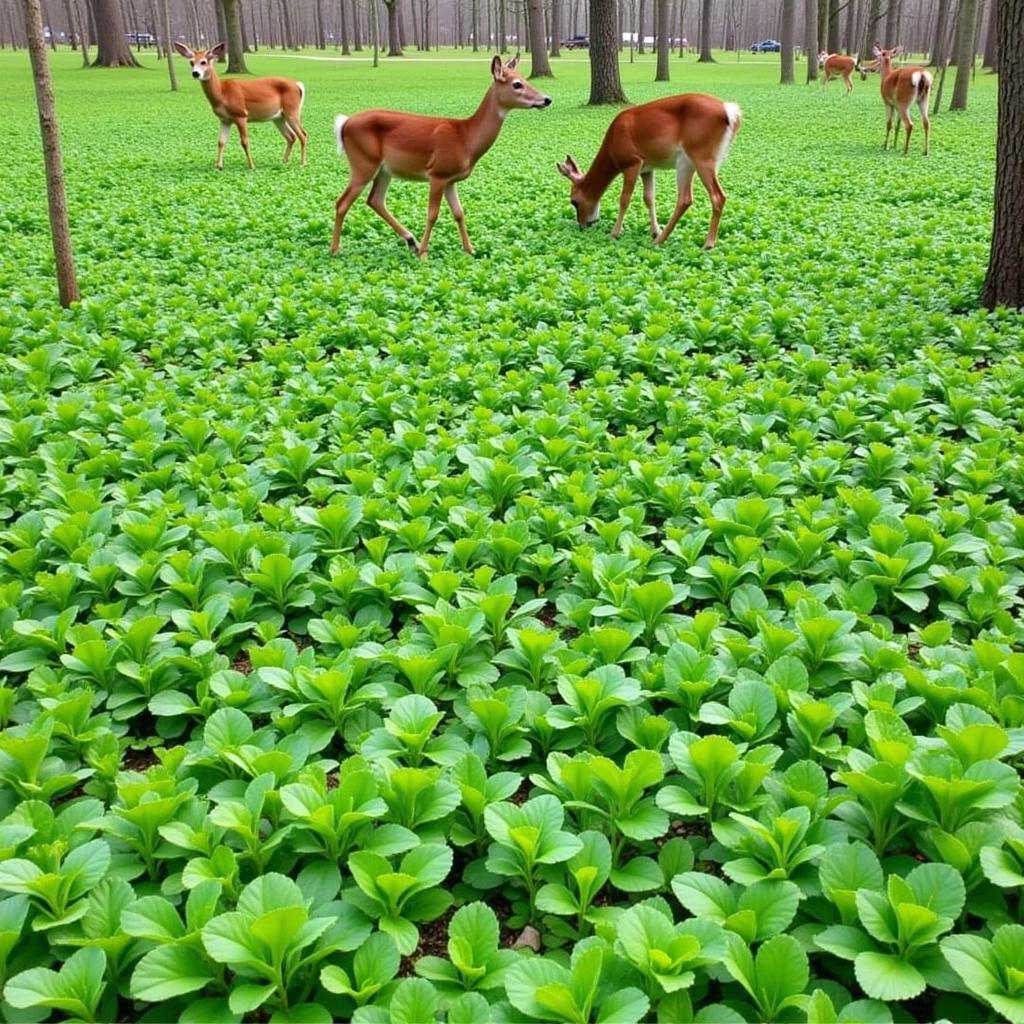Radish Deer Food Plots offer hunters an effective and affordable way to attract and hold deer on their property. But there’s more to creating a thriving radish plot than just scattering seeds. This guide delves into the specifics of using radishes in your food plot strategy, from choosing the right variety to maximizing their attractiveness for deer. Let’s dig in!
Why Choose Radish for Your Deer Food Plot?
Radishes, specifically varieties like forage radish or daikon radish, are a popular choice for deer food plots for several compelling reasons. First, they’re a brassica, meaning they’re packed with nutrients deer crave, especially during the fall and winter months when other food sources become scarce. Second, they’re relatively quick-growing, establishing themselves rapidly after planting. Finally, the large, nutritious roots break up compacted soil, improving overall soil health for future plantings. Thinking about big tine food plot? Radishes can be a great addition!
Selecting the Right Radish Variety
Not all radishes are created equal when it comes to deer food plots. Forage radishes, also known as tillage radishes, are generally preferred due to their larger root size and cold tolerance. Daikon radishes are another excellent option, offering similar benefits. Consider your local climate and soil conditions when making your selection.
- Forage Radish: Excellent cold tolerance, large roots, improves soil health.
- Daikon Radish: Similar to forage radish, known for its deep taproots.
Planting and Maintaining Your Radish Deer Food Plot
The ideal time to plant radish deer food plots is late summer or early fall, allowing them to establish before the first frost. A well-prepared seedbed is crucial for successful germination. Make sure to remove any existing vegetation and till the soil to a depth of several inches. What about the best time to plant other food plot options? Check out when to plant winter food plots for deer.
 Planting a Radish Deer Food Plot
Planting a Radish Deer Food Plot
Watering and Fertilization
While radishes are relatively drought-tolerant, adequate moisture is essential for optimal growth. If rainfall is scarce, consider supplementing with irrigation. A balanced fertilizer can also boost growth and nutrient content. Are you looking for affordable options for your plot? Explore cheap food plot seed.
Maximizing the Attractiveness of Your Radish Plot
To make your radish plot irresistible to deer, consider incorporating other attractive forage options. Mixing radishes with other brassicas, such as turnips or rape, can create a diverse and highly palatable food source. This “salad bar” approach ensures deer have a variety of nutrients to choose from.
Protecting Your Plot from Pests
Deer aren’t the only creatures attracted to a lush radish plot. Pests like insects and rodents can also damage your hard work. Implementing pest control measures can help protect your investment and ensure a bountiful harvest for the deer.
 Mature Radish Deer Food Plot
Mature Radish Deer Food Plot
Radish Deer Food Plots: A Long-Term Investment
Planting radish deer food plots isn’t just about attracting deer for the current season. The deep roots of radishes help break up compacted soil, improving its overall structure and health. This benefits future plantings, creating a more fertile and productive environment for years to come. For specific seed recommendations in certain areas, check out michigan food plot seed. Looking for effective fall blends? Consider best fall food plot blends.
Conclusion
Radish deer food plots offer a cost-effective and beneficial way to enhance your hunting property and attract deer. By carefully selecting the right variety, implementing proper planting techniques, and incorporating strategies to maximize attractiveness, you can create a thriving food plot that will keep deer coming back for more.
FAQ
- When is the best time to plant radish deer food plots? Late summer or early fall.
- What type of radish is best for deer? Forage radish or daikon radish.
- Do radishes need a lot of water? They are drought-tolerant but benefit from adequate moisture.
- Can I mix radishes with other plants in my food plot? Yes, especially other brassicas.
- How do radishes benefit soil health? Their deep roots break up compacted soil.
- Are radish plots expensive to maintain? Generally, they are considered affordable.
- What pests should I be aware of? Insects and rodents.
John Doe, a Wildlife Biologist with over 20 years of experience, advises, “Radishes are a fantastic choice for food plots, offering both nutritional value for deer and soil improvement benefits for landowners.”
Another expert, Jane Smith, a seasoned hunter and food plot enthusiast, adds, “I’ve seen firsthand how effective radish plots can be in attracting and holding deer, especially during the late season.”
Finally, David Lee, a local farmer and hunting guide, emphasizes the importance of soil preparation: “A well-prepared seedbed is crucial for successful radish establishment and growth. Don’t skimp on this step!”
Need help with your food plot strategy? Contact us at Phone Number: 02437655121, Email: minacones@gmail.com or visit us at 3PGH+8R9, ĐT70A, thôn Trung, Bắc Từ Liêm, Hà Nội, Việt Nam. We have a 24/7 customer service team ready to assist you.